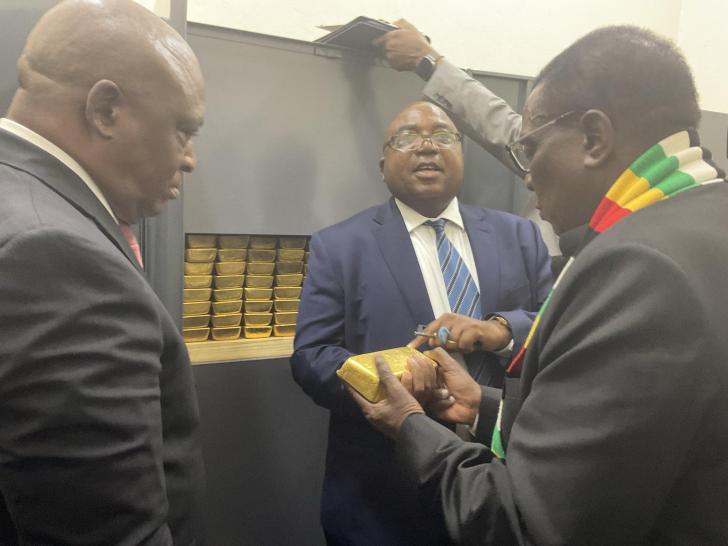News / National
Mnangagwa inspects Zimbabwe's gold reserves
19 Jun 2025 at 12:38hrs |
0 Views

President Emmerson Mnangagwa on Thursday morning conducted a high-profile inspection of Zimbabwe's gold reserves held in the Reserve Bank of Zimbabwe (RBZ) vaults, following his directive for the country to build gold stockpiles to anchor its national currency.
The visit comes as Zimbabwe's strategic gold holdings have now surpassed the critical three-tonne benchmark, positioning the country sixth on the African continent in terms of official gold reserves. Algeria currently tops the list.
President Mnangagwa's visit underscored his administration's commitment to strengthening the fundamentals behind the recently introduced Zimbabwe Gold (ZiG) currency, which is backed by the country's mineral wealth—primarily gold.
"This milestone is a direct result of the policy decision made two years ago to accumulate gold reserves as a foundation for a stable and sovereign national currency," the President said during the inspection. "We are building a financial architecture that is firmly anchored in our natural endowments."
The RBZ gold reserves have been steadily growing under a deliberate accumulation programme, which involves local gold purchases and refined production stored under secure conditions at the central bank.
RBZ officials who accompanied the President said Zimbabwe's continued investment in gold not only boosts confidence in the local currency but also enhances the country's ability to withstand global financial shocks.
"With escalating geopolitical uncertainties, many economies are returning to gold as a secure asset. Zimbabwe's position as a noted gold producer puts it in good stead to align with this global trend," said one RBZ official.
The shift toward building gold reserves aligns with broader global economic patterns, where gold is increasingly being treated as a hedge against inflation and currency volatility. Zimbabwe's approach mirrors that of countries such as Russia, China, and Turkey, which have significantly ramped up their gold holdings in recent years.
President Mnangagwa emphasized that the accumulation of gold is part of a long-term national resilience strategy and a key pillar of the Second Republic's economic reform agenda.
The government has also introduced several initiatives to formalize the gold sector, increase output, and curb illicit mineral trade, with the aim of ensuring that the country's vast resources benefit national development goals.
Zimbabwe produced over 30 tonnes of gold in 2024, according to official figures, with a significant portion now being retained by the central bank under the reserve strategy.
As the ZiG currency continues to stabilize and gain public confidence, authorities hope the gold reserves will serve not only as a symbol of sovereignty but also as a tangible asset backing a sustainable economic future.
The visit comes as Zimbabwe's strategic gold holdings have now surpassed the critical three-tonne benchmark, positioning the country sixth on the African continent in terms of official gold reserves. Algeria currently tops the list.
President Mnangagwa's visit underscored his administration's commitment to strengthening the fundamentals behind the recently introduced Zimbabwe Gold (ZiG) currency, which is backed by the country's mineral wealth—primarily gold.
"This milestone is a direct result of the policy decision made two years ago to accumulate gold reserves as a foundation for a stable and sovereign national currency," the President said during the inspection. "We are building a financial architecture that is firmly anchored in our natural endowments."
The RBZ gold reserves have been steadily growing under a deliberate accumulation programme, which involves local gold purchases and refined production stored under secure conditions at the central bank.
RBZ officials who accompanied the President said Zimbabwe's continued investment in gold not only boosts confidence in the local currency but also enhances the country's ability to withstand global financial shocks.
"With escalating geopolitical uncertainties, many economies are returning to gold as a secure asset. Zimbabwe's position as a noted gold producer puts it in good stead to align with this global trend," said one RBZ official.
The shift toward building gold reserves aligns with broader global economic patterns, where gold is increasingly being treated as a hedge against inflation and currency volatility. Zimbabwe's approach mirrors that of countries such as Russia, China, and Turkey, which have significantly ramped up their gold holdings in recent years.
President Mnangagwa emphasized that the accumulation of gold is part of a long-term national resilience strategy and a key pillar of the Second Republic's economic reform agenda.
The government has also introduced several initiatives to formalize the gold sector, increase output, and curb illicit mineral trade, with the aim of ensuring that the country's vast resources benefit national development goals.
Zimbabwe produced over 30 tonnes of gold in 2024, according to official figures, with a significant portion now being retained by the central bank under the reserve strategy.
As the ZiG currency continues to stabilize and gain public confidence, authorities hope the gold reserves will serve not only as a symbol of sovereignty but also as a tangible asset backing a sustainable economic future.
Source - online
Join the discussion
Loading comments…

































